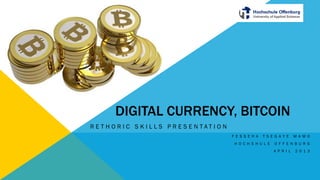Digital currency, Bitcoins
- 1. DIGITAL CURRENCY, BITCOIN R E T H O R I C S K I L L S P R E S E N T A T I O N F E S S E H A T S E G A Y E M A M O H O C H S H U L E O F F E N B U R G A P R I L 2 0 1 3
- 2. CONTENTS ŌĆó Money and Digital Currency ŌĆó Cryptocurrency ŌĆó Bitcoin ’é¦ Concept ’é¦ Statistics and market vlaue ’é¦ What can you do with bitcoins?
- 3. MONEY AND DIGITAL CURRENCY ŌĆó Electronic money that acts as alternative currency ŌĆó They are not produced by government-endorsed banks ŌĆó Unlike virtual money they are used in transactions of real goods and services
- 5. CRYPTOCURRENCY ŌĆó Holder has ownership ŌĆó No other records kept as to identity of owner ŌĆó Easy to keep anonymous http://en.wikipedia.org/wiki/Digital_currency
- 6. CRYPTOCURRENCY ... ŌĆó Hard or impossible to replace if lost or stolen ŌĆó Derives trust from mathematical properties ŌĆó Based on established, trusted cryptographic primitives http://en.wikipedia.org/wiki/Digital_currency
- 7. BITCOIN ŌĆó Decentralized ŌĆó Anonymous ŌĆó Created via peer-to-peer networks ŌĆó Concept created by ŌĆ×Satoshi NakamotoŌĆ£
- 8. BITCOIN CONCEPT ŌĆó Public but anonymous transactions ŌĆó Based on block chaining of cryptographically- signed transactions ŌĆó Miners ŌĆō secure the system
- 9. BITCOIN CONCEPT ... ŌĆó Miners are awarded bitcoins or transaction fees for successfully finding blocks ŌĆó ~21million bitcoins https://en.bitcoin.it/wiki/File:Total_bitcoins_over_time_graph.png
- 13. WHAT CAN YOU DO WITH BITCOINS? ŌĆó Snacks ŌĆó Vitamins and supplements ŌĆó Website hosting ŌĆó A sports car! http://blockchain.info/charts/
- 15. Traveling the Silk Road: A measurement analysis of a large anonymous online marketplace

















